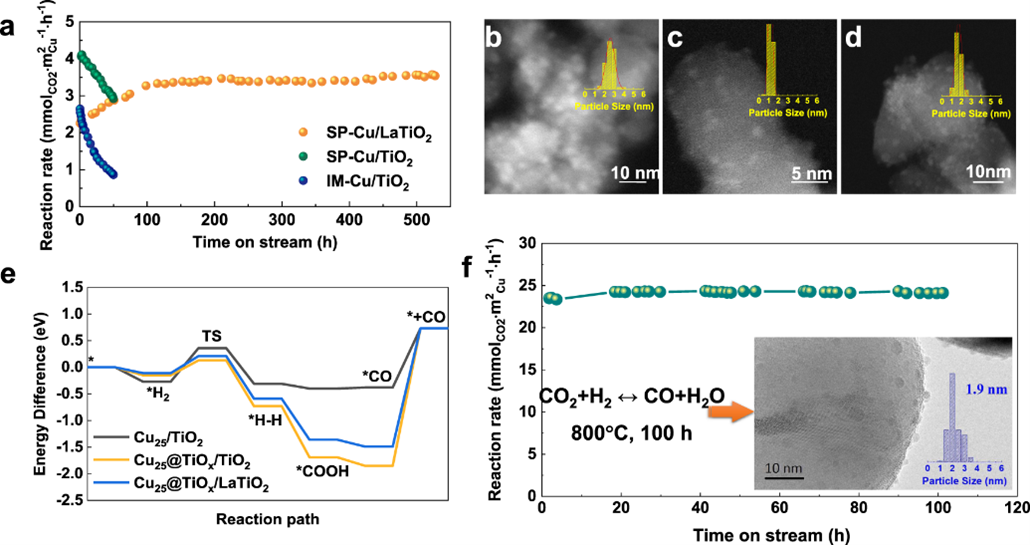Ultra-high thermal stability of sputtering reconstructed Cu-based catalysts
Summary
The research group of Prof. Noritatsu Tsubaki (School of Engineering, University of Toyama) fabricate the strong metal-support interaction (SMSI) between sputtering reconstructed Cu and flame-made LaTiO2 support at a mild reduction temperature, exhibiting an ultra-stable performance for more than 500 h at 600 °C. The sintering of Cu nanoparticles is effectively suppressed even at as high as 800 °C. The critical factors to success are reconstructing the electronic structure of Cu atoms in parallel with enhancing the support reducibility, which makes them adjustable by sputtering power or decorated supports.
Research background
Cu-based catalysts have shown large reaction diversity and great potential in many industrial processes1, such as NOx removal in automobile applications, steam reforming, CO/CO2 hydrogenation, photo/electro-catalysis, and oxygen reduction reaction. However, their applications are seriously limited by the lack of sufficient thermal stability due to the nature of copper’s low Tammann temperature2, resulting in nanoparticles sintering via surface migration. This process will be further accelerated in the presence of water2. As reported, the traditional Cu–Zn–Al catalyst lost 70% activity in 15 h in reverse water gas shift (RWGS) reaction at 600 °C. As a result, the operating temperatures for those catalysts must be restricted, usually to below 300 °C, inspiring the rational design of anti-sintering Cu-based catalysts at higher temperatures.
Results
We designed an ultra-stable Cu-based catalyst for high-temperature RWGS reaction, We created the classic SMSI on non-noble metal Cu-based catalyst at mild reduction temperatures for the first time, and realized controllable preparation of ultra-highly stable Cu-based catalyst. This catalyst exhibited ultra-stable performance for more than 500 hours at 600 °C. The sintering of Cu nanoparticles was effectively suppressed even at 800 °C.
Moreover, the strength of SMSI could be effectively controlled not only by reducing temperatures as before but also by tailor-made Cu via sputtering power regulation or decorated supports for rational catalyst design on demands.

Fig.1: Thermal stability of Cu-based catalysts at high temperatures.
a Stability tests in RWGS reaction at 600 °C over IM-Cu/TiO2, SP-Cu/TiO2, and SP-Cu/LaTiO2 samples.
b–d ADF-STEM images and particle size distributions of b SP-Cu/LaTiO2-500R,
c SP-Cu/LaTiO2-100h, and d SP-Cu/LaTiO2-500h catalysts.
e Comparison of the RWGS reaction path over three models from DFT calculations.
f Long-term thermal stability of SP-Cu/LaTiO2 at 800 °C. Inset was the TEM image and the distribution of Cu nanoparticles of the used catalyst.
Future direction
The present study provided a feasible strategy to establish an ultra-stable Cu-based catalyst at an ultimate temperature as high as 800 °C in a long-time investigation, which opened a new territory in the application of Cu in heterogeneous catalysis.
Reference
- Gawande, M. B. et al. Cu and Cu-based nanoparticles: synthesis and applications in catalysis. Chem. Rev. 116, 3722–3811 (2016).
- Twigg, M. V. & Spencer, M. S. Deactivation of supported copper metal catalysts for hydrogenation reactions. Appl. Catal. A Gen. 212, 161–174 (2001).
Original article information
Journal
Nature Communications
Title
Ultra-high thermal stability of sputtering reconstructed Cu-based catalysts
Authors
Jiafeng Yu 1, Xingtao Sun 1,2, Xin Tong 1,2, Jixin Zhang 1, Jie Li3 Shiyan Li 1,2, Yuefeng Liu * 1, Noritatsu Tsubaki *4 Takayuki Abe5& Jian Sun *1
1Dalian National Laboratory for Clean Energy, Dalian Institute of Chemical Physics, Chinese Academy of Sciences, 116023 Dalian, China.
2University of Chinese Academy of Sciences, 100049 Beijing, China.
3 School of Chemistry and Chemical Engineering, Yangzhou University, 225002 Yangzhou, China.
4Department of Applied Chemistry, School of Engineering, University of Toyama, Gofuku 3190, Toyama 930-8555, Japan.
5Hydrogen Isotope Research Center, University of Toyama, Gofuku 3190, Toyama 930-8555, Japan

